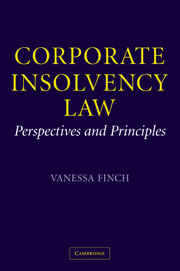Book contents
- Frontmatter
- Contents
- Acknowledgements
- Table of cases
- Table of statutes and other instruments
- List of abbreviations
- Introduction
- Part I Agendas and objectives
- Part II The context of corporate insolvency law: financial and institutional
- Part III The quest for turnaround
- Part IV Gathering and distributing the assets
- 12 Gathering the assets: the role of liquidation
- 13 The pari passu principle: when everyone is equal?
- 14 Bypassing pari passu
- Part V The impact of corporate insolvency
- Conclusion
- Bibliography
- Index
13 - The pari passu principle: when everyone is equal?
Published online by Cambridge University Press: 05 June 2012
- Frontmatter
- Contents
- Acknowledgements
- Table of cases
- Table of statutes and other instruments
- List of abbreviations
- Introduction
- Part I Agendas and objectives
- Part II The context of corporate insolvency law: financial and institutional
- Part III The quest for turnaround
- Part IV Gathering and distributing the assets
- 12 Gathering the assets: the role of liquidation
- 13 The pari passu principle: when everyone is equal?
- 14 Bypassing pari passu
- Part V The impact of corporate insolvency
- Conclusion
- Bibliography
- Index
Summary
A fundamental rule of corporate insolvency law is said to be enshrined in the pari passu principle. This holds that in a winding up creditors shall share rateably in those assets of the insolvent company that are available for residual distribution. ‘Rateably’ here means in common proportions according to the extent of their pre-insolvency claims: as opposed, for instance, to ranking in order of the time at which the claim was established.
This, and the following chapter, consider whether the pari passu principle operates in an efficient and fair manner and whether there is a case for approaching post-insolvency distribution in a different way. Issues of accountability and expertise will not be addressed since pari passu is a substantive rule governing the distribution of goods and little is to be gained by asking whether a principle is, in itself, accountable or expert. Whether insolvency principles are administered accountably and expertly are matters dealt with in other chapters.
As noted previously in chapter 12, creditors are free, prior to winding up, to pursue whatever enforcement measures are open to them: for example, repossession of goods or judgment execution. Indeed, the race goes to the swiftest. Liquidation puts an end to the race as the liquidator is responsible for the orderly realisation of assets for the benefit of all unsecured creditors and for distributing the net proceeds pari passu. The pari passu principle, however, can only apply to unencumbered assets of the insolvent company that are available for distribution.
- Type
- Chapter
- Information
- Corporate Insolvency LawPerspectives and Principles, pp. 421 - 449Publisher: Cambridge University PressPrint publication year: 2002



